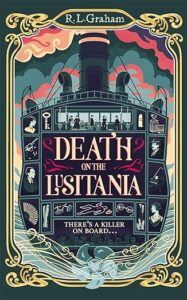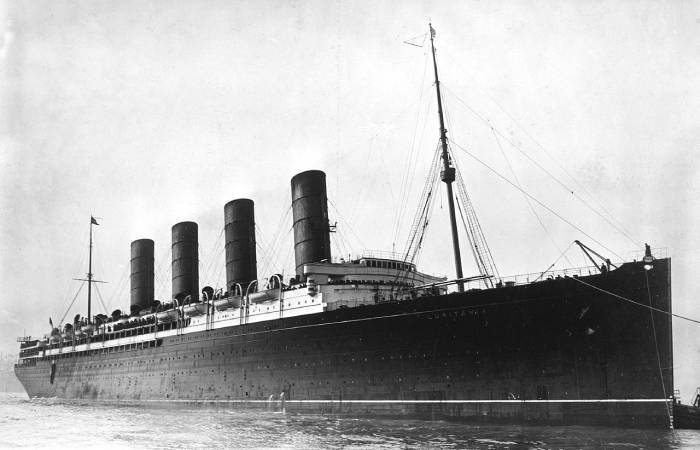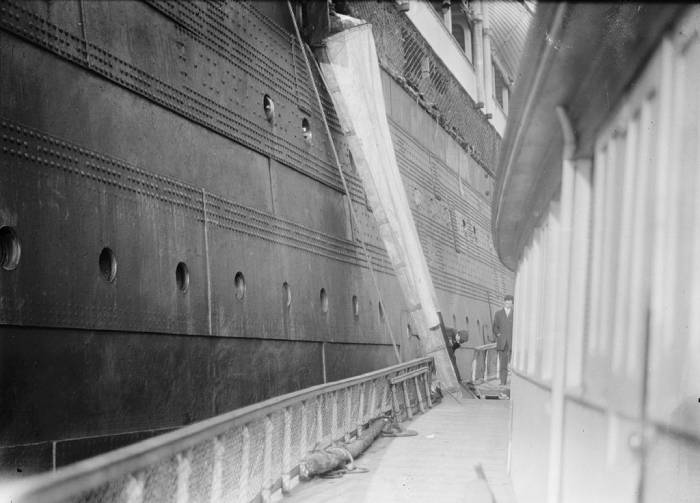Finding the Lusitania with R.L. Graham
Finding the Lusitania with R.L. Graham
The cosy crime book Finding Death on the Lusitania is about a real ship and a real moment in history. Well, I had to get THAT author on The BookTrail didn’t I? Or rather those authors, since this is a double act!

Map of locations in Death on the Lusitania
Launched in 1906, the Lusitania was the largest and most luxurious passenger ship in the world. She was also one of the fastest. Today, everyone knows the story of the Titanic, but the Lusitania has largely been forgotten. At the time, though, she was a symbol of maritime pride and power for her owners, Cunard Lines, and for Britain itself. All that came to an end in May 1915 when Lusitania was torpedoed and sunk off the coast of Ireland with a loss of nearly twelve hundred lives.

Quote from the book (c) Panmacmillan
Map of locations in Death on the Lusitania
In May 1987, an excited young couple boarded the liner Stefan Batory in Montreal, on their way to begin a new life in England. Many years later that young couple – us, Marilyn Livingstone and Morgen Witzel writing as RL Graham – sat down to write Death on the Lusitania, a thriller set on the doomed liner, and we went back at once to our own experience of the Atlantic crossing. The Stefan Batory was one of the last old-fashioned liners to cross the Atlantic, and though she was nowhere near as luxurious as Lusitania, she still had echoes of the golden age of trans-Atlantic travel; menus printed in French, passengers watching pods of whales on a sunny afternoon, an elderly lady who sat alone painting delicate traceries on Easter eggs.

The Lusitania (c) Wikipedia
Map of locations in Death on the Lusitania
Sailing on an ocean liner, we discovered, was a little like living in a village. We saw the same people everyday, sat at the same table for meals, developed habits and routines. Two memories dominated our thinking. The first was the sense of enclosure; even on a big ship, there were only so many places we can go. Some of our fellow passengers found this comforting, but others become claustrophobic. The second was the vastness of the sea around us, and the sense of immense isolation, sailing thousands of miles from the nearest land. Again, some people were excited by this, but there could also be a sense of oppression; if anything went wrong on board the ship, we had nowhere to go. All of this was absolutely perfect for writers of detective fiction.

The Lusitania floor plans (c) Wikipedia
Map of locations in Death on the Lusitania
However, we were up against one hurdle. Usually, when writing about historical locations, we could go and visit them. Even if only ruins remained, that was still enough to spur the imagination. But Lusitania no longer existed; the wreck lies in several hundred fathoms of water in the Irish Sea. Fortunately, plenty of evidence remains. Sailing on the Stefan Batory gave us a rough idea of how ocean liners functioned, and deckplans of the ship are still visible.

The Lusitania mail room (c) Wikipedia
Map of locations in Death on the Lusitania
We read every book we could find about the building of the ship and the experiences of passengers, looked at dozens of photographs of the interior rooms, and pieced together an idea of what she looked like; the Louis Seize dining room, all baroque plaster and painted panels; the green marble fireplaces and green and yellow patterned carpet in the saloon; the staterooms, each unique, decorated in art nouveau patterns; the smoking room, where gentlemen played cards and tried not to think about the submarines lurking in the depths outside.

The Lusitania (c) Wikipedia
Map of locations in Death on the Lusitania
The only place where we had to use our imagination was in the cargo hold. There are no photographs of this for obvious reasons; Lusitania’s tragic secret was that, on her final voyage, she was carrying artillery shells and munitions from American factories destined for the British army fighting in France. Here we used the existing deckplans and worked out how we could design this secret cargo space and control access to it. As the climactic scenes of the book take place here, it couldn’t be just a big empty space; the hold had to have its own secrets.

The opening chapter of the book sees Lusitania sailing down the Hudson River in New York, passengers watching as the city slides by. The final chapter is set in an Irish hotel room after the sinking when the truth – or some of it; in Death on the Lusitania, it is not always easy to know what truth is – is finally laid bare. The rest is dominated by just two locations: the ship, and the sea.
Thank you both for this fascinating trail and visit on board!
BookTrail Boarding Pass: Death on the Lusitania
Twitter: @panmacmillan The author is not on social media




